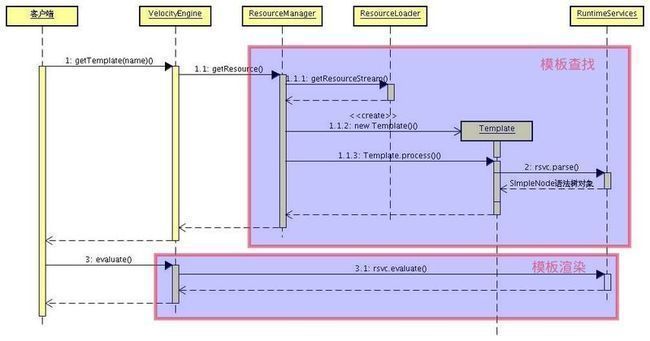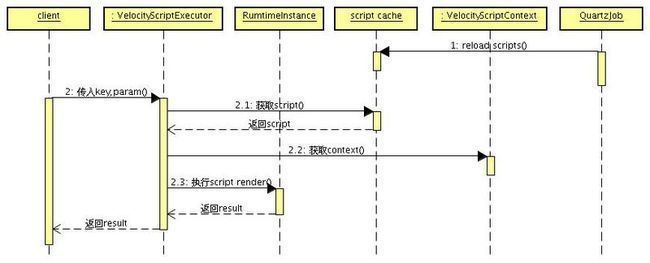velocity的另一种使用"简易动态语言"
背景
相信大家对velocity这一类模板语言都并不陌生,一般velocity大部分是在web应用中,替换jsp的一种选择,做为html页面的渲染。实现UED和开发人员的分离。
但在最近的一个项目中,遇到了一个比较"另类"的需求,就是我们需要抓取一个外部网站的页面内容信息,比如aleax排名。
设计
针对这样的需求,设计上需要考虑的点:
- 外部网站不稳定,超时时间的设置,访问的域名变化(域名换成ip等)
- 我们需要精确抓取外部网站的信息,外部网站页面的任意变化,都会导致抓取失败
- 有几个类似的需求,需要进行统一考虑
分析:
1. 外部网站的请求。可以使用HttpClient,使用开源的技术可以减少一些风险,比如编码问题,SSL支持,POST提交等问题。
2. 网站的信息分析和抓取,得看具体网站的返回信息,需要支持各种协议的数据。比如xml , json , 普通的html。
3. 外部网站页面变化的应对策略:
- 外部网站的抓取策略是可以配置型,比如xml或者数据库。这里比较倾向于数据库,通过一个后台页面,进行CRUD的管理。这样可以做到及时的响应,而不需要重新发布代码。
- 对外部网站的抓取结果定时进行监控。 比如模拟请求一次,监控具体的返回结果,如有问题进行手机报警。
大的技术内容已经明确,这里主要考虑的是如何设计灵活的抓取策略的规则。
抓取策略大致内容:
1. 构造请求参数,不同的页面有不同的参数
2. 获取外部网站返回结果。比如返回编码处理
3. 解析对应的返回内容,按照json,xml,字符串进行处理。
4. 返回对应的结果。 不同页面的返回结果会出现不同。
因为按照需求设计分析,已经很明确抓取策略的这一块仅仅是通过xml这类静态配置会设计的很复杂,很明显一类动态语言比较适合干这样的活,但项目组中对动态语言基本没使用,大部门下使用的也几乎没有,存在比较大的技术风险。这时候,就轮到velocity登场了,使用模板语言代替动态语言。事实证明,使用velocity处理这类问题也挺适合
常见的velocity处理过程:
总的来说,可以分为两步: 模板查找,模板渲染。
模板查找:
根据给定的name,返回对应的String,InputSteam流。
模板渲染:boolean evaluate( Context context, Writer out, String logTag, String instring )
根据给定的上下文,和模板内容,进行渲染,并将最终的合并结果直接输出到Writer中。
项目特殊使用:
1. 模板查找:
因为对应的模板来自于数据库,所以这里就直接省去了模板查找的这一过程,直接给出对应的script。 同样你也可以使用velocity自带提供的基于database的模板查找DataSourceResourceLoader。
resource.loader = ds ds.resource.loader.public.name = DataSource ds.resource.loader.description = Velocity DataSource Resource Loader ds.resource.loader.class = org.apache.velocity.runtime.resource.loader.DataSourceResourceLoader ds.resource.loader.resource.datasource = java:comp/env/jdbc/Velocity ##依赖jndi ds.resource.loader.resource.table = tb_velocity_template ds.resource.loader.resource.keycolumn = id_template ds.resource.loader.resource.templatecolumn = template_definition ds.resource.loader.resource.timestampcolumn = template_timestamp ds.resource.loader.cache = false ds.resource.loader.modificationCheckInterval = 60
因为项目使用的是spring database管理,所以这里不用velocity自带的一套。
2. 模板渲染:
构造了自己的Context,进行页面渲染。直接从context获取对应的返回结果,因为velocity默认是进行字符串输出,对于复杂的返回对象不好处理
减简过后,最后的类设计:
对应的时序图:
核心类代码
public class VelocityScriptExecutor implements ScriptExecutor {
private static final String RESULT = "result";
private static final int DEFAULT_CACHE_SIZE = 1000;
private RuntimeInstance ri = new RuntimeInstance();
private Map<String, SimpleNode> cache;
private int cacheSize = DEFAULT_CACHE_SIZE;
private Properties velocityProperties;
private boolean needCache = true;
private static final Writer nop = new Writer() { //自定义空的write对象
public void close() throws IOException {
}
public void flush() throws IOException {
}
public void write(char[] cbuf, int off, int len) {
}
};
public void initialize() throws ScriptException {
if (cacheSize <= 0) {// 不考虑cacheSize为0的情况,强制使用LRU cache机制
cacheSize = DEFAULT_CACHE_SIZE;
}
cache = new LRULinkedHashMap<String, SimpleNode>(cacheSize);
// 初始化velocity instance
ri.setProperty(RuntimeConstants.RUNTIME_LOG_LOGSYSTEM, new NullLogChute());// 设置日志输出
if (velocityProperties != null) {
try {
ri.init(velocityProperties);
} catch (Exception e) {
throw new ScriptException(e);
}
}
}
/**
* <pre>
* 1. 接受VelocityScriptContext上下文,自身并不关心所谓的pullTool的存在
* 2. script针对对应name下的script脚本
* </pre>
*/
public Object evaluate(ScriptContext context, String script) throws ScriptException {
InternalContextAdapterImpl ica = new InternalContextAdapterImpl((AbstractContext) context);
SimpleNode nodeTree = null;
if (needCache) {
nodeTree = get(script);
}
if (nodeTree == null) {
try {
nodeTree = ri.parse(new StringReader(script), "");
} catch (Exception e) {
throw new ScriptException(e);
}
nodeTree.init(ica, ri);
if (needCache) {
put(script, nodeTree);
}
}
try {
nodeTree.render(ica, nop);
} catch (Exception e) {
throw new ScriptException(e);
}
return ica.get(RESULT); //直接从context中获取对应#set(result=xxx),对应的result变量
}
public class VelocityScriptContext extends AbstractContext implements ScriptContext {
private Map context = new HashMap(); // 基于map的上线文实现
private Map pullTool = new HashMap(); // pullTool上下文实现
@Override
public boolean internalContainsKey(Object key) {
return context.containsKey(key) || pullTool.containsKey(key);
}
@Override
public Object internalGet(String key) {
return context.get(key) != null ? context.get(key) : pullTool.get(key);
}
@Override
public Object[] internalGetKeys() {
return context.keySet().toArray();
}
@Override
public Object internalPut(String key, Object value) {
return context.put(key, value);
}
@Override
public Object internalRemove(Object key) {
return context.remove(key);
}
// ================== setter / getter =======================
public void setContext(Map context) {
this.context = context;
}
public void setPullTool(Map pullTool) {
this.pullTool = pullTool;
}
}
说明:
pulltool的概念就是类似于velocity toolbox提供的一堆工具util,比如HttpClientTool , JsonTool , XmlTool。可以按照自己的需求封装对应的tool.
最后一个script配置实现:(比如抓取google收录某关键字的记录数)
##处理参数
#set($keyword = $param.keyword)
#set($userAgent = $param.userAgent)
## 构造url
#set($url="http://www.google.com.hk/search?hl=zh-CN&q=${keyword}")
## 获取页面
#set($param=$httpClient.createParam())
$param.config.setReadTimeout(3000)
$param.config.setConnectionTimeout(3000)
$param.config.setContentEncoding("UTF-8")
$param.header.setUserAgent($userAgent)
#set($html=$httpClient.request($url,$param))
## 处理页面
#set($recordNum=$stringTool.substringBetween($html,"找到约","条结果"))
#set($cost=$stringTool.substringBetween($html,"(用时","秒)"))
#set($record=$stringTool.trim($record))
#set($cost=$stringTool.trim($cost))
## 生成返回结果
#set($result = $resultTool.createMap())
$result.put("recordNum",$recordNum)
$result.put("cost",$cost)
返回结果,一个map对象,包含了两个key,一个是记录数,一个是耗时。最后在页面上展示时,可以包装成json对象进行控制和显示。
{recordNum="4,140,000,000 ",cost="0.13"}
最后
本文并没有太多高深的技术,只是对velocity的另一种使用,用于解决一些特定的业务场景。欢迎大家拍砖!


